Modern Minimalism with Bone White is the perfect blend of simplicity and sophistication, making it an ideal choice for contemporary interiors. This guide will take you through the beauty of natural color tones, focusing on how bone white can create a clean, calming atmosphere while adding subtle warmth to your space. Discover tips and ideas to incorporate this timeless hue into your minimalist design for a truly modern and elegant look.
Bone White: The Perfect Blend of Minimalism and Warmth
In the world of interior design, few color choices offer the perfect balance of warmth, sophistication, and versatility quite like bone white. This subtle yet powerful neutral has steadily gained recognition among designers and homeowners seeking a foundation that bridges the gap between stark minimalism and cozy comfort.
Bone white can be described as a natural white with gentle beige undertones, creating a soft, organic appearance that feels both timeless and contemporary. Unlike pure whites that can sometimes feel clinical or harsh, bone white provides a subtle warmth that makes spaces feel instantly more inviting while maintaining clean, uncluttered aesthetics.
The historical significance of bone white extends back centuries. Traditional Japanese design has long embraced similar neutral tones, valuing their ability to create harmony and balance. In Western architecture, bone white gained prominence during the neoclassical period, where it adorned the walls of elegant estates and public buildings, providing the perfect backdrop for architectural details and artwork.
Today, bone white has experienced a remarkable resurgence in modern minimalist design. As more people embrace the “less is more” philosophy, bone white offers a compelling alternative to stark whites. Its subtle complexity provides visual interest without overwhelming a space, making it particularly attractive to those seeking to create calm, thoughtful environments free from visual clutter.
The rising popularity of bone white also coincides with a growing desire for sustainable, nature-inspired design. Its organic quality evokes natural materials like limestone, bone, and unbleached textiles, connecting indoor spaces with the natural world. For modern minimalists who value authenticity and simplicity, bone white represents the perfect intersection of contemporary design and timeless natural beauty.
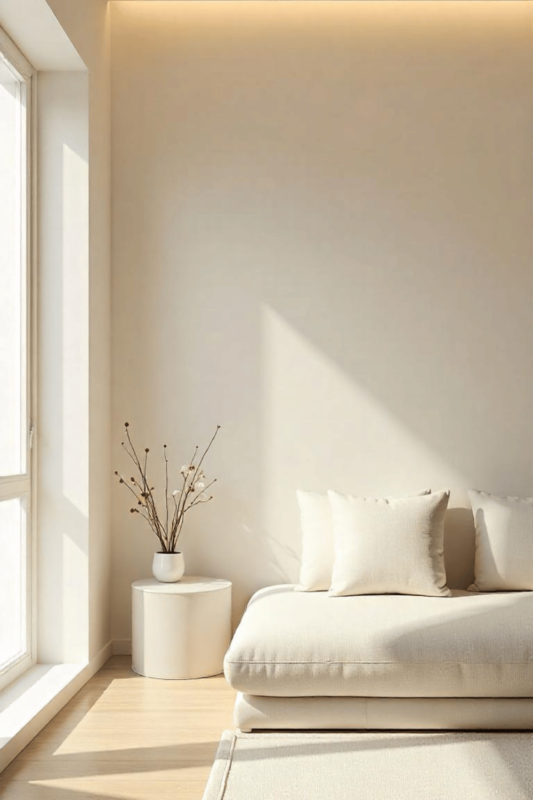
The Psychology of Bone White: How This Subtle Neutral Affects Our Minds and Spaces
In the world of interior design, colors do more than just decorate our spaces—they actively shape our psychological responses and emotional states. Bone white, with its gentle beige undertones and organic warmth, offers a particularly fascinating study in color psychology.
The Emotional Response to Bone White
Unlike stark whites that can sometimes feel clinical or harsh, bone white creates an immediate sense of calm and simplicity in spaces. This subtle neutral tone works on our emotional state in several key ways:
- It evokes feelings of natural harmony, connecting to the organic world through its similarity to natural materials like limestone and unbleached textiles
- The warmth in bone white makes spaces feel instantly more inviting while still maintaining clean aesthetics
- Its understated complexity provides a sense of sophistication without overwhelming our senses
How Bone White Affects Spatial Perception
One of bone white’s most powerful psychological effects relates to how it transforms our perception of space and light. When used in interiors:
- It creates a sense of openness and breathing room, particularly valuable in smaller spaces
- Unlike pure whites that can create harsh reflections, bone white diffuses light more gently, creating balanced illumination
- The subtle depth of bone white provides just enough visual interest to define architectural features without overwhelming them
Cognitive Benefits of Neutral Environments
Modern minimalists are increasingly drawn to bone white not just for aesthetic reasons but for its cognitive benefits. Research suggests that environments featuring neutral tones like bone white can:
- Reduce visual stress by eliminating the overstimulation that comes with bright colors or busy patterns
- Promote mental clarity and focus by creating a backdrop that doesn’t compete for attention
- Support cognitive processes by providing a visually restful environment that allows the mind to process information more efficiently
Bone White in the Modern Minimalist Movement
The rising popularity of bone white aligns perfectly with the values of modern minimalism. For those embracing the “less is more” philosophy, bone white offers:
- A compelling alternative to stark whites that can sometimes feel cold or uninviting
- An authentic connection to natural elements, supporting the sustainable design principles many minimalists value
- The perfect intersection of contemporary design sensibilities and timeless natural beauty
Whether you’re redesigning your entire home or simply refreshing a single room, considering the psychological impact of bone white might just transform not only your space but also how you think, feel, and function within it.

Bone White in Interior Design: The Natural Elegance of Modern Minimalism
Bone white stands as one of the most versatile and sophisticated neutrals in the modern designer’s palette. With its natural white appearance and gentle beige undertones, it creates spaces that feel both timeless and contemporary. Let’s explore how this elegant shade can transform your interior spaces.
Wall Applications: The Perfect Canvas
Bone white walls create an ideal backdrop for minimalist spaces. Unlike stark whites that can feel clinical, bone white offers warmth and sophistication while maintaining clean aesthetics. This subtle neutral pairs beautifully with architectural features, allowing them to shine without overwhelming the space.
When used on walls, bone white diffuses light more gently than pure whites, creating balanced illumination throughout your space. This quality makes it particularly valuable in rooms with varying light conditions or smaller spaces where you want to create a sense of openness.
Furniture: Minimalist Elegance
Minimalist furniture pieces in bone white tones offer a perfect balance between form and function. Whether it’s a sleek sofa, a simple dining table, or streamlined storage solutions, bone white furniture creates a sense of cohesion without dominating the visual field.
The subtle complexity of bone white provides just enough visual interest to define furniture pieces while supporting the “less is more” philosophy that modern minimalists embrace. For those seeking to create calm, thoughtful environments free from visual clutter, bone white furniture offers an authentic connection to natural elements.
Textiles and Soft Furnishings: Layers of Texture
One of bone white’s greatest strengths is its ability to showcase texture. In textiles and soft furnishings, this quality becomes particularly apparent. Linens, cottons, and other natural materials in bone white create layers of subtle interest through texture rather than color.
This approach aligns perfectly with minimalist principles, where quality and tactile experience take precedence over decorative excess. The organic quality of bone white evokes natural materials like unbleached textiles, connecting indoor spaces with the natural world.
Flooring Options: Grounding the Space
Bone white flooring options in wood, stone, and tile applications provide a foundation that feels both clean and organic. In wood flooring, bleached or limewashed oak or ash can achieve this gentle neutral tone. In stone and tile, materials like limestone, travertine, or matte porcelain can deliver the desired effect.
The right bone white flooring creates a sense of continuity and flow, visually expanding the space while providing a serene foundation for minimalist interiors. Like other bone white applications, these flooring choices reduce visual stress by eliminating overstimulation, allowing the mind to process information more efficiently.
Conclusion: Timeless Versatility
Bone white offers the perfect intersection of contemporary design sensibilities and timeless natural beauty. Whether you’re redesigning your entire home or simply refreshing a single room, considering the psychological and aesthetic impact of bone white might just transform not only your space but also how you think, feel, and function within it.
By embracing this sophisticated neutral in your walls, furniture, textiles, and flooring, you create environments that honor the principles of modern minimalism while avoiding the coldness that can sometimes characterize minimalist spaces. The result is a home that feels both elegantly restrained and warmly inviting—the true hallmark of successful interior design.

Creating Contrast with Bone White: Elevating Minimalist Spaces
Bone white has emerged as a cornerstone in modern minimalist design, offering warmth and sophistication that pure whites often lack. However, the true magic of bone white happens when we thoughtfully introduce contrast to prevent spaces from feeling flat or uninspiring. Here’s how to master the art of creating contrast with bone white while maintaining minimalist elegance.
Pairing with Darker Neutrals
One of the most effective ways to enhance bone white’s subtle beauty is by strategically introducing darker neutrals. This creates depth and visual interest without compromising minimalist principles:
- Try incorporating charcoal or soft black elements through furniture pieces like dining chairs or accent tables
- Deep brown wooden elements provide organic contrast while maintaining a natural palette
- Consider a statement wall in a deeper neutral tone to create architectural focus
The key is balance—darker neutrals should complement rather than overwhelm bone white surfaces. This approach creates sophisticated spaces that feel both grounded and airy.
Adding Texture: The Minimalist’s Secret Weapon
In minimalist design where color is used sparingly, texture becomes essential for creating visual interest. Bone white provides the perfect canvas for textural exploration:
- Layer different textiles like nubby linen, smooth cotton, and plush wool in varying bone white tones
- Incorporate natural materials like unfinished wood, stone, or rattan to add organic texture
- Consider tactile wall treatments such as limewash, plaster, or textured wallpaper in bone white
These textural contrasts create depth and dimension without relying on bold colors or patterns, perfect for the discerning minimalist who appreciates subtle complexity.
Strategic Color Accents
While minimalism often favors neutral palettes, strategic pops of color against bone white create memorable visual impact:
- Choose one or two accent colors rather than a rainbow approach—consider muted terracotta, sage green, or dusty blue
- Introduce color through smaller, easily changeable elements like pillows, vases, or artwork
- Consider the psychological impact of your chosen accent colors—blues for calm, greens for rejuvenation, earth tones for groundedness
Remember that in minimalist design, restraint is key. Your color accents should feel intentional and purposeful rather than random additions.
Finding Balance
The most successful bone white interiors find the perfect balance between contrast and cohesion. Too much contrast can disrupt the peaceful quality that makes bone white so appealing, while too little can result in spaces that feel bland.
By thoughtfully incorporating darker neutrals, rich textures, and strategic color accents, you can create minimalist spaces that showcase bone white’s sophisticated warmth while maintaining visual interest and depth—proving that “less is more” doesn’t have to mean “less interesting.”
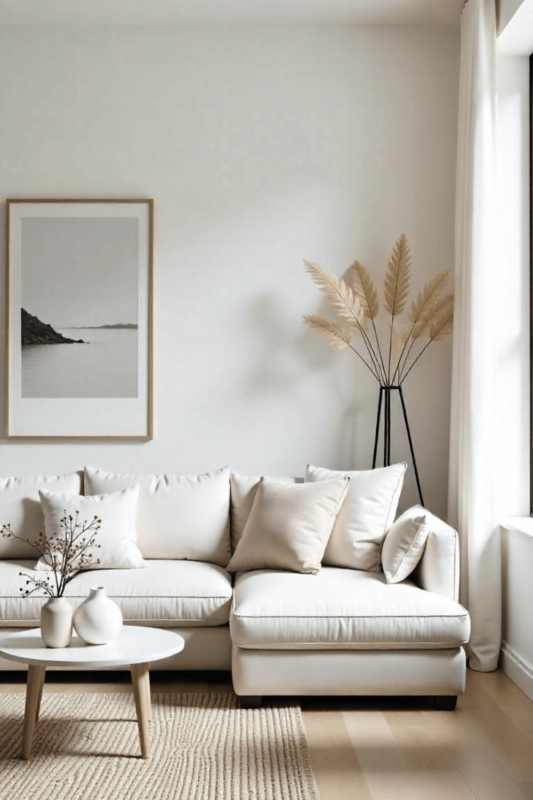
Bone White for Different Architectural Styles: A Versatile Neutral for Every Space
Bone white has emerged as one of the most sophisticated neutrals in modern design, offering warmth and subtle complexity that pure whites often lack. What makes this elegant shade truly remarkable is its chameleon-like ability to enhance various architectural styles while maintaining its distinctive character. Let’s explore how bone white adapts to different design aesthetics.
Scandinavian Minimalism: A Natural Harmony
Scandinavian design and bone white create a perfect partnership. The principles of Scandinavian minimalism—simplicity, functionality, and connection to nature—align beautifully with bone white’s organic warmth. In these light-filled spaces, bone white walls provide a soft, reflective surface that maximizes natural light without the harshness of pure white.
The subtle beige undertones of bone white complement the natural materials essential to Scandinavian design: light woods, natural textiles, and handcrafted elements. This creates spaces that feel both clean and cozy—the essence of the famous “hygge” concept that makes Scandinavian interiors so inviting.
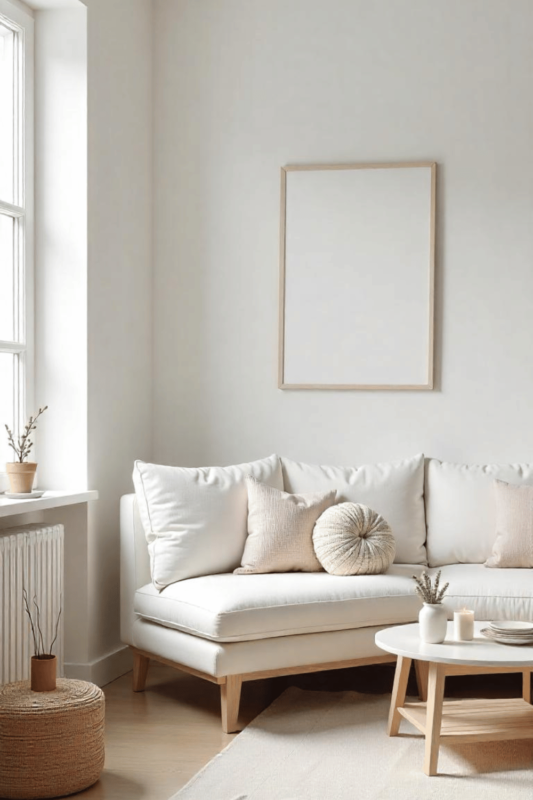
Contemporary Spaces: Sophisticated Simplicity
In sleek, modern environments, bone white functions as both a sophisticated neutral and a statement in itself. Contemporary architecture often features bold lines, open spaces, and architectural details that bone white enhances without competing for attention.
The subtle complexity of bone white provides just enough visual interest against the clean lines characteristic of contemporary design. When paired with materials like glass, steel, and polished concrete, bone white creates a balance between warmth and coolness, preventing modern spaces from feeling sterile or impersonal.
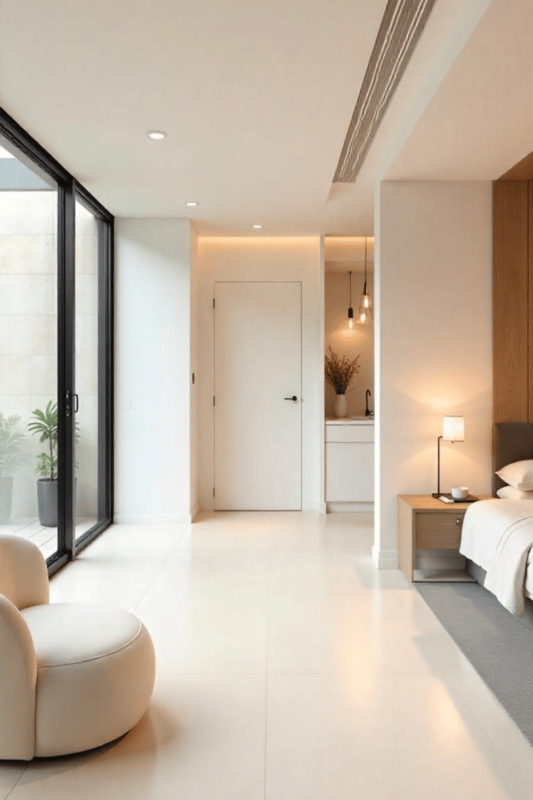
Industrial Design: Softening the Edge
Industrial architecture celebrates raw materials and structural elements. Bone white offers the perfect counterpoint to these sometimes harsh features, combining with raw materials to create balanced industrial aesthetics.
Against exposed brick, ductwork, or steel beams, bone white surfaces create a thoughtful contrast that softens the industrial edge without diminishing its character. This combination honors the authentic history of industrial spaces while making them more livable and inviting.

Japanese-Inspired Spaces: Embracing Wabi-Sabi
Perhaps one of the most fascinating applications of bone white is in Japanese-inspired architecture, where it connects deeply with the wabi-sabi philosophy. This traditional Japanese worldview embraces imperfection, transience, and the beauty of natural aging—qualities that bone white embodies perfectly.
In these spaces, bone white surfaces provide a quiet backdrop for carefully curated elements. Its subtle imperfections and natural variations align with wabi-sabi’s celebration of authenticity and impermanence, creating interiors that feel both timeless and profoundly peaceful.
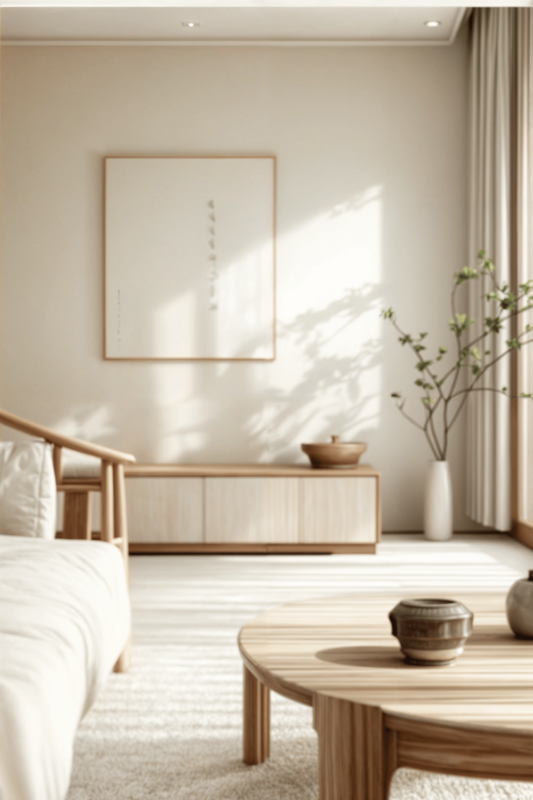
The Universal Appeal of Bone White
What makes bone white truly exceptional is its ability to transcend architectural styles while enhancing their distinctive qualities. Whether in a minimalist Scandinavian cottage, a sleek urban loft, a converted industrial space, or a Japanese-inspired retreat, bone white adapts while maintaining its core characteristics: warmth, sophistication, and natural elegance.
For designers and homeowners seeking a versatile neutral that works across different architectural contexts, bone white offers unparalleled flexibility without sacrificing character. It’s not just a color—it’s a design philosophy that celebrates subtlety, authenticity, and the profound beauty of restraint.
Practical Considerations for Working with Bone White: A Complete Guide
Bone white has become a designer favorite for creating elegant, minimalist spaces. However, this sophisticated neutral requires thoughtful consideration to maintain its subtle beauty. Let’s explore the practical aspects of working with bone white to ensure your design vision translates perfectly into reality.
Lighting Impact: How Environment Transforms Bone White
Perhaps no factor influences bone white more dramatically than lighting. This versatile neutral responds differently to various light conditions:
- Natural Light: In north-facing rooms, bone white may appear cooler and more muted. In south-facing spaces, it can take on a warmer, more luminous quality. East and west exposures create changing effects throughout the day.
- Artificial Lighting: LED, incandescent, and fluorescent lights each bring out different undertones in bone white. Warm lighting enhances its beige undertones, while cooler light sources may highlight subtle gray notes.
- Testing Strategy: Always sample bone white in the actual space before committing. Paint large swatches on different walls and observe them throughout the day to understand how your specific lighting conditions will affect the final result.
Maintenance Factors: Keeping Bone White Fresh
While bone white offers timeless appeal, maintaining its pristine appearance requires proactive care:
- Cleaning Protocol: Use gentle, non-abrasive cleaners on bone white surfaces. Harsh chemicals can damage finishes and alter the subtle coloration over time.
- Touch-Up Strategy: Keep records of exact paint formulations for future touch-ups. Even slight variations in bone white can be noticeable when patching.
- Protection Measures: Consider practical protections in high-traffic areas, such as washable finishes for walls or performance fabrics for bone white upholstery.
- Aging Considerations: Be aware that bone white may develop a patina over time, particularly in areas exposed to sunlight. This can enhance its character but should be anticipated in your design planning.
Paint and Finish Selection: Finding Your Perfect Bone White
Navigating the world of bone white products requires understanding both color and finish options:
- Paint Formulations: Each paint manufacturer offers slightly different bone white formulations. Research undertones carefully—some lean more yellow, others more gray or pink.
- Finish Impact: The same bone white color can appear dramatically different in various finishes. Matte finishes often appear softer and more velvety, while satin or semi-gloss finishes reflect more light and can make the color appear slightly brighter.
- Application Methods: Consider specialty application techniques like lime wash, chalk paint, or milk paint for adding textural interest to bone white surfaces while maintaining its subtle elegance.
- Material Considerations: Remember that bone white appears differently across various materials. A bone white ceramic tile will look different from bone white painted drywall or bone white fabric, even when the color formula is similar.
Practical Selection Process
When selecting bone white for your space, follow this methodical approach for best results:
- Collect samples of several bone white options that appeal to you
- Test them in your actual space at different times of day
- Consider how they interact with existing materials and furnishings
- Select finishes appropriate to the function of each surface
- Document your selections for future reference and maintenance
By carefully considering these practical aspects of working with bone white, you can create spaces that not only look beautiful on day one but continue to maintain their sophisticated elegance for years to come.
Case Studies: Successful Bone White Interiors
Bone white has emerged as a designer favorite for creating spaces that feel both sophisticated and serene. Let’s explore how this versatile neutral has been masterfully applied in various settings, from intimate residential spaces to expansive commercial environments.
Residential Examples: Minimalist Elegance in Everyday Living
The true versatility of bone white shines in residential applications, where it creates peaceful retreats that still feel distinctly personal:
- The Jensen Residence: This Scandinavian-inspired coastal home uses bone white as its primary palette throughout the open-concept living areas. The designers paired bone white walls with natural oak flooring and minimal furnishings, allowing the home’s spectacular ocean views to become the focal point. The subtle warmth of bone white prevents the space from feeling cold despite the abundance of glass and natural light.
- The Miyazaki Apartment: In this compact urban dwelling, bone white transforms a potentially cramped space into an airy sanctuary. The designers embraced Japanese minimalist principles, using bone white on both walls and built-in storage elements to create a sense of continuity. Strategic textural elements—a handwoven wool rug, linen drapery, and ceramic accessories—prevent the monochromatic scheme from feeling flat.
- The Harper Brownstone: This historic renovation demonstrates how bone white honors architectural heritage while creating contemporary living spaces. Original moldings and millwork painted in bone white retain their distinctive character without overwhelming the interior. The designers introduced contrast through carefully selected furniture pieces in rich walnut and brass accents, creating a space that feels both timeless and current.
Commercial Applications: Creating Focused, Tranquil Environments
Forward-thinking businesses have discovered that bone white environments can enhance productivity and wellbeing:
- Serene Wellness Center: This boutique spa uses bone white as the foundation for a restorative environment. The designers paired bone white walls with pale limestone flooring and natural linen privacy curtains. The result is a space that feels clean and clinical enough to inspire confidence while remaining warm and inviting—a delicate balance that pure white often fails to achieve.
- Kinfolk Publishing Offices: This creative workspace demonstrates how bone white can foster focus and creativity. Open workstations feature bone white surfaces that minimize visual distraction, while textural elements—exposed brick, woven pendant lights, and leafy plants—prevent the environment from feeling sterile. Employees report feeling more centered and less visually overwhelmed than in their previous brightly-colored office.
- Northlight Gallery: This contemporary art space uses bone white as more than just a neutral backdrop. The subtle undertones in the walls interact differently with changing exhibitions and lighting conditions, becoming an active element in the viewing experience. The gallery director notes that artists specifically request the space for its ability to complement rather than compete with their work.
Designer Insights: Expert Perspectives on Bone White
Leading interior designers share their experiences working with this sophisticated neutral:
- Maria Björnson, Stockholm-based minimalist designer: “Bone white contains multitudes. It’s never just one color—it shifts throughout the day, responding to natural light in a way that brings spaces alive. When clients request ‘white interiors,’ I often guide them toward bone white for its livability and subtle complexity.”
- James Chen, commercial space specialist: “In workplace design, we’ve moved away from sterile whites that can increase eye strain and stress. Bone white provides the brightness clients want while creating a more supportive visual environment. It’s become our studio’s default recommendation for creative and wellness-focused businesses.”
- Sophia Morales, residential designer: “The trick with bone white is understanding that it’s rarely about using just one shade. In my most successful projects, I layer slightly different bone white tones—some warmer, some cooler—to create depth without introducing contrast. It’s a subtle approach that creates incredibly sophisticated results.”
These case studies reveal bone white’s remarkable adaptability across different contexts and design visions. Whether in a family home seeking tranquility, a business fostering productivity, or an art space celebrating creativity, bone white provides a foundation that is neither stark nor boring, but richly nuanced and endlessly versatile.
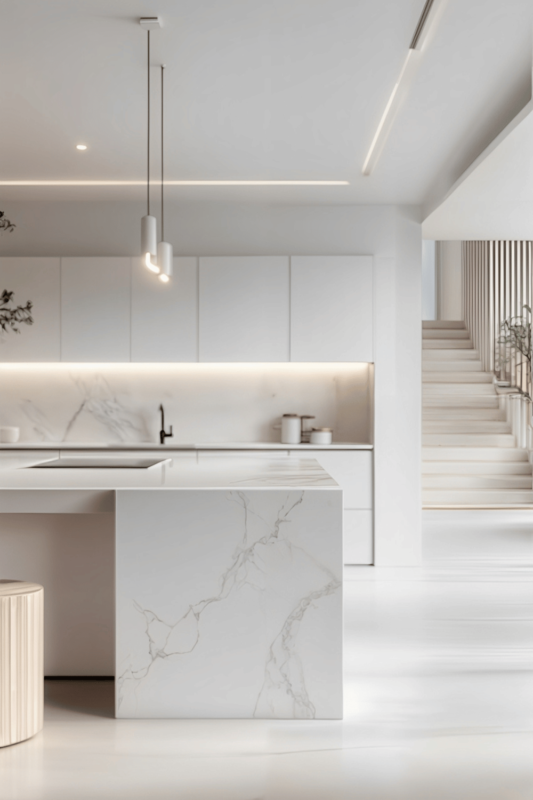
Conclusion: The Timeless Elegance of Bone White
As we’ve explored throughout this comprehensive guide, bone white stands as an exceptional choice in the world of interior design—not merely a trend, but a timeless classic that continues to enchant designers and homeowners alike.
Bone white’s subtle complexity offers what few other neutrals can: warmth without heaviness, character without overwhelming, and a chameleon-like ability to enhance architectural features while creating a sense of calm. This sophisticated neutral transcends fleeting fashion, remaining relevant through changing design cycles.
The Enduring Relevance of Bone White
What makes bone white truly timeless is its connection to both history and nature. Unlike stark whites that feel clinical or trendy colors that quickly date, bone white draws from organic forms that have appealed to humans for centuries. Its subtle undertones mimic natural materials that have adorned homes throughout history—from ancient marble to hand-polished bone implements.
This connection to both tradition and nature ensures bone white will continue to feel relevant long after more dramatic color trends have faded. As we increasingly seek authenticity in our environments, bone white’s organic character provides a genuine foundation for thoughtful design.
A Versatile Foundation for Any Style
Perhaps bone white’s greatest strength lies in its remarkable versatility. As we’ve seen through numerous examples, this sophisticated neutral enhances virtually every design approach:
- In minimalist spaces, it provides warmth and subtle texture that pure white cannot
- In traditional settings, it honors historical elements while feeling fresh
- In eclectic interiors, it creates a cohesive backdrop for diverse furnishings
- In natural schemes, it complements raw materials with organic elegance
This adaptability makes bone white not only a safe choice for those uncertain about color but a sophisticated one for those who understand how subtle neutrals can enhance architectural features and curated elements.
Practical Recommendations for Working with Bone White
For those considering bone white for their spaces, these final recommendations will help ensure success:
- Test thoroughly – Always sample bone white options in your actual space under different lighting conditions before committing
- Consider undertones – Choose bone white variations with undertones that complement your existing materials and desired mood
- Layer thoughtfully – Create depth by incorporating various bone white tones and textures rather than using a single shade throughout
- Balance with contrast – Introduce selective elements of contrast through texture, material, or carefully chosen accent colors
- Invest in quality – Select high-quality paint formulations and materials to fully appreciate bone white’s subtle nuances
As we conclude our exploration of bone white, it’s clear that this sophisticated neutral offers far more than meets the casual eye. Its subtle complexity, historical resonance, and remarkable versatility make it not merely a color choice but a design philosophy—one that celebrates restraint, authenticity, and the profound beauty found in nuance.
In a world increasingly drawn to the authentic and timeless, bone white stands as a testament to the enduring power of subtle sophistication—proving that the most compelling statements are often made in whispers rather than shouts.
>> Learn more: How to Choose the Best Modern Kitchen Appliances for Your Home?


